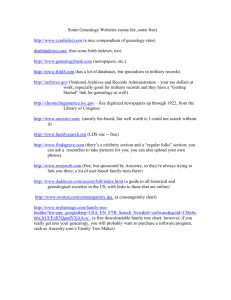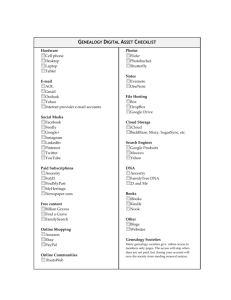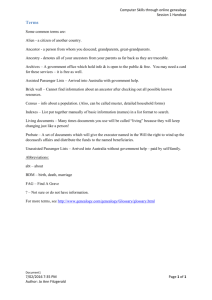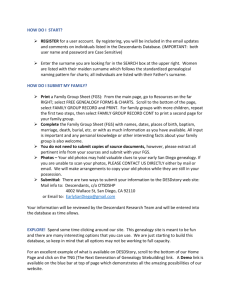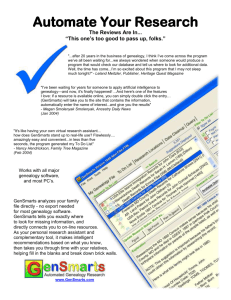GECO Genealogy Project
advertisement
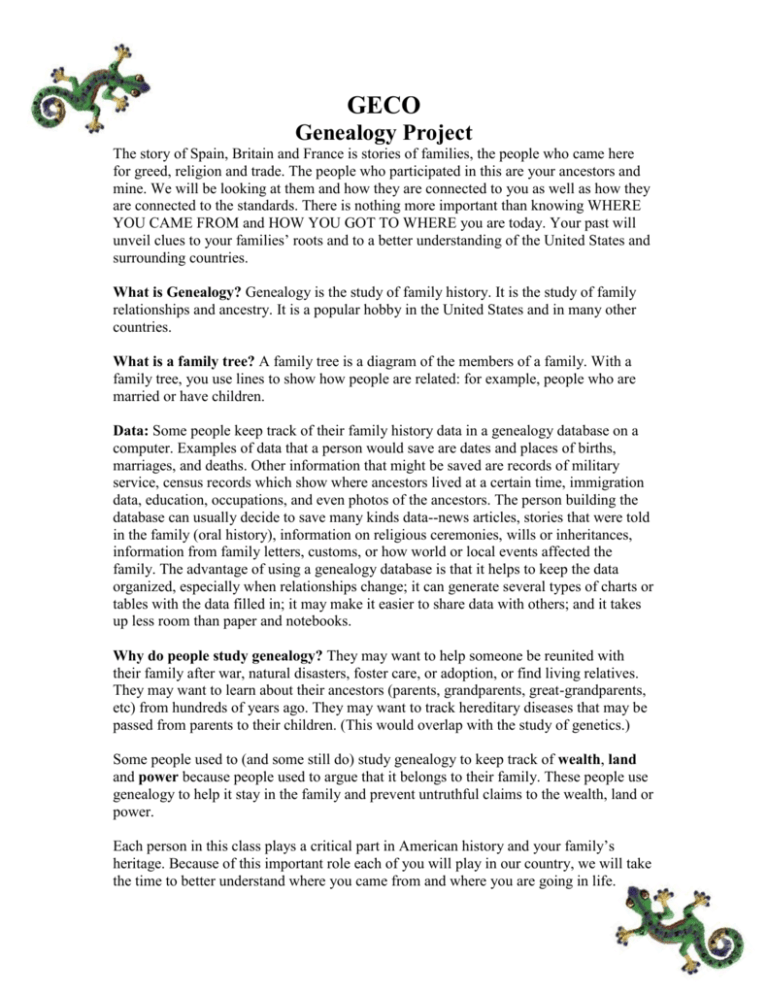
GECO Genealogy Project The story of Spain, Britain and France is stories of families, the people who came here for greed, religion and trade. The people who participated in this are your ancestors and mine. We will be looking at them and how they are connected to you as well as how they are connected to the standards. There is nothing more important than knowing WHERE YOU CAME FROM and HOW YOU GOT TO WHERE you are today. Your past will unveil clues to your families’ roots and to a better understanding of the United States and surrounding countries. What is Genealogy? Genealogy is the study of family history. It is the study of family relationships and ancestry. It is a popular hobby in the United States and in many other countries. What is a family tree? A family tree is a diagram of the members of a family. With a family tree, you use lines to show how people are related: for example, people who are married or have children. Data: Some people keep track of their family history data in a genealogy database on a computer. Examples of data that a person would save are dates and places of births, marriages, and deaths. Other information that might be saved are records of military service, census records which show where ancestors lived at a certain time, immigration data, education, occupations, and even photos of the ancestors. The person building the database can usually decide to save many kinds data--news articles, stories that were told in the family (oral history), information on religious ceremonies, wills or inheritances, information from family letters, customs, or how world or local events affected the family. The advantage of using a genealogy database is that it helps to keep the data organized, especially when relationships change; it can generate several types of charts or tables with the data filled in; it may make it easier to share data with others; and it takes up less room than paper and notebooks. Why do people study genealogy? They may want to help someone be reunited with their family after war, natural disasters, foster care, or adoption, or find living relatives. They may want to learn about their ancestors (parents, grandparents, great-grandparents, etc) from hundreds of years ago. They may want to track hereditary diseases that may be passed from parents to their children. (This would overlap with the study of genetics.) Some people used to (and some still do) study genealogy to keep track of wealth, land and power because people used to argue that it belongs to their family. These people use genealogy to help it stay in the family and prevent untruthful claims to the wealth, land or power. Each person in this class plays a critical part in American history and your family’s heritage. Because of this important role each of you will play in our country, we will take the time to better understand where you came from and where you are going in life. GECO Genealogy Project Semester I The GOAL of this project is to provide each and every student with an understanding of his or her heritage, as well as the history of the US. During the first semester, you will complete 7 steps of the GECO project. Each step must be completed by the due date assigned in class. Because each of these seven assignments is what our District calls a term assignment, the work is due at the beginning of your period on the day announced and may not be turned in late for credit, even with an excused readmit. STEP 1: The first step in this process will be to find your oldest living relative on each side of your family (mom and dad) and have a phone conversation with each of them about your family and its history. If the relative is alive, but can’t carry on a conversation very well, you can choose the next-oldest member on that side of the family. If you are not living with any relatives or aware of any living relatives, see Mr. P for instructions on how to complete this step and the other six in this project. Ask your relative what he or she remembers about the family by asking specific questions like what states or countries has the family lived in, what kinds of jobs have been held by family members, what kinds of houses and cars where owned by family members. Ask about important events in the family over the years and ask for stories about the oldest relative they person you are talking with can remember. The conversation you had with both relatives will need to be summarized in memo format to me. Do not stress. I will teach you memo format. The body of the memo should be at least ____ words. (Names of persons and what was talked about regarding heritage) (25 points) STEP 2: Go to GENI.com or and create a FREE account. This will be where all your data will be stored, so write down your password. www.geni.com To build your family tree on (not due to Nov.) www.ancestry.com Mother of all searches (free for 14 days and at library) www.archive.com 2nd best of all searches (Free 7 days) www.rootsweb.com Cross reference website (free) http://www.freebmd.org.uk/ Free UK genealogy helper http://www.rootsweb.ancestry.com/~casoccgs/ What we will be using at school Family History Centers in Orange: LDS 949-364-2742 Hours: Tues-Wed 9:30-4:30 & 6:00-9:00 pm; Thur. 9:00 am-4:30 pm, Sat. 9:30-1:00 pm Mission Viejo Library: Will be teaming with us the hours are listed below. MV Library Hours Genealogy Desk hours: Sunday - 1 - 4 Monday - 10 - 7 Tuesday - 10 - 7 Wednesday - 10 - 8 MV Library contact: Thursday - 10 - 7 Friday - 1 - 4 Saturday - 10 - 4 (Third Saturday 1 – 4) Mary Joe Mcqueen mcqueenmaryjo@aol.com STEP 3: Choose either your mother’s side of the family or father’s side of the family and create a family three that shows your ancestors as far back as you can research in the time given to you. Use the tree distributed in class to display your family as we will be using this in the library. You will be expected to complete 5-6 generations (1861), assuming each generation is about 30 years. You are required to research only one side of the family, but you may research both if you wish. Your family tree should show AT LEAST mother and the father from each generation and the siblings in the family if you can find them. For each generation, provide the specific information about each family member, the minimum for each family member will be name and birth and, if applicable, death dates of each. Below are some other resources available to make this easier. http://genealogysearch.org/free/forms.html STEP 4: Each person will be responsible for turning in 10 PRIMARY SOURCE DOCUMENTS. Each generation you research should have at least one, but not more than two primary source documents. There must also be a description attached to the primary source document that explains: What it is? What specific information did it provide about your family tree? What did you find interesting about the document? If you are doing the city project you will only need 5. (100 points) STEP 5: 10 PHOTOS Each person will be responsible for 10 photos of your family. These will need to be in either black and white or color. The older the photos are the better. They need to represent the side of the family you are doing and should be labeled and in chronological order. (50 points) STEP 6: MAP You will create a MAP showing the locations of your family over the years. I will provide the map and you will provide the locations that show movement of your family over the years. This will be due sometime at the end of the semester and will connect to your ongoing research about your family. Each map must have an explanation of the moves on the back of the map with numbers indicating where your family had settled. (25 points) http://genealogy.about.com/od/geography/a/google.htm STEP 7: GECO UPDATES I will be requiring GECO updates from each and every one of you on a bi-monthly basis. These assignments will be produced in memo format and are updates on the research that is taking place. The memos describe the process of the research you are conducting and summarize the new and exciting info you have researched, including the sources you have been using and what you have found. Some of the updates will focus on a specific generation and some will focus on what you have accomplished over a number of days or weeks that I will announce. Below you will find the categories you will use to describe your research. GECO CATEGORIES Geography: Location is really important especially when it relates to work, job, and how one goes about their daily lives. This part of the memo will explain the geography related to your family history. Where is your family living? How does the location affect the life of your family? What changes are taking place in the geography involving people and/or the environment? Events: What are the global, national and local events that surround your family and caused them to do what they did. For example my grandfather, who fought in WWII, was adopted in 1917. His adoption probably only happened because the law at that time allowed for the parents to seal the documents containing his adoption permanently to keep it private. Would he have been adopted if that was not the case? This sections will explain how the events of the time you are writing about caused your family to make certain decisions. Culture: What did your family eat? What did they drink? What kind of house did they have? What did they do for fun when not working? How did they live? So much of this information is located online now, you can pretty much look up the time period and find out what was done culturally. Remember the people of the past did not have a lot of free time as they were busy surviving day to day. Occupation: The occupation that one does is related to the skills one has at the time. In the past, usually one’s skills were related to how much money one had thus making it difficult for one with no money to become rich or skilled. This section will represent how skilled your family was in the past and specific information about the different occupations that were shared throughout the years. (25 points each) RUBRIC MEMO WITH OLDEST LIVING RELATIVE 25 points FAMILY TREE AND MEMO 50 points PRIMARY SOURCE DOCUMENTS (10) 100 points PHOTOS 50 points (10 photos) MAP: (must show movement and why on the back) 25 points GECO UPDATES: 25 points per update (3 of them) PROJECT NEATNESS (1asee below) TOTAL 50 points /350 PROJECT POINTS NOTES: 1a. I will be collecting everything at the end of the semester nice and neatly put into a binder. You will be graded on neatness and completion. You can always go back and put something in you missed but will only get credit for it at this time as there is no make up credit for any parts of this project. 1b. This project is not something you can throw together the night before as there will be due dates throughout the semester. It is also a term project so that means everything is due regardless of what happens. You can have it to me by the end of class or time stamped in my mailbox. Although, if you miss a pop quiz that day you cannot make it up and HW will be posted on my site.
